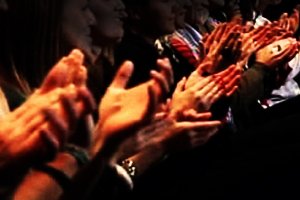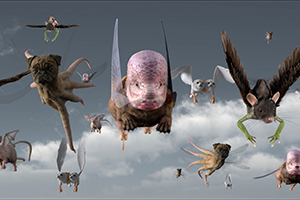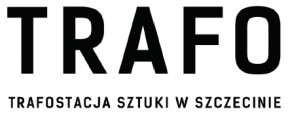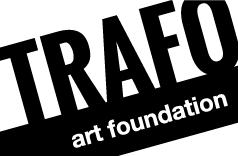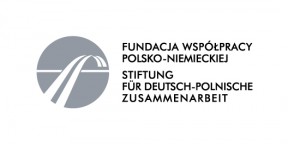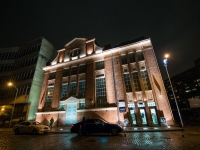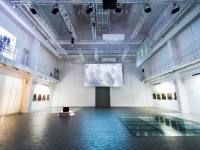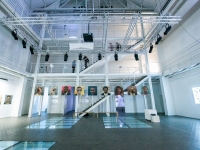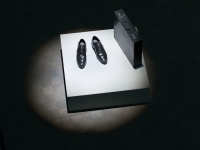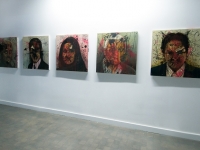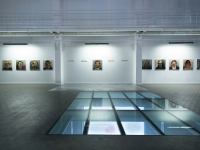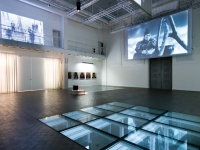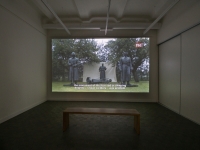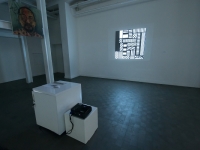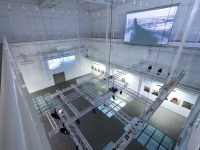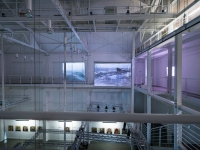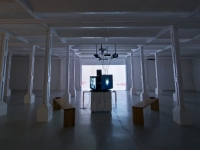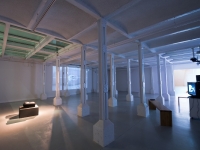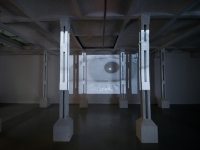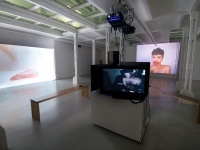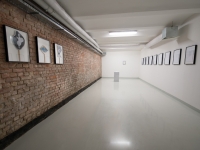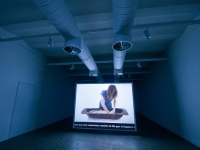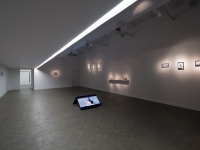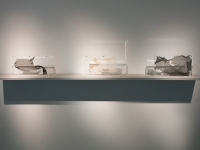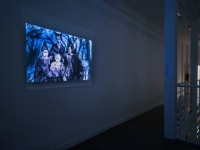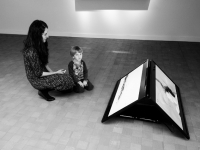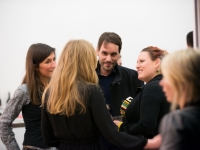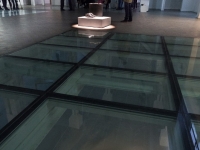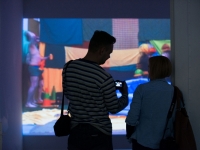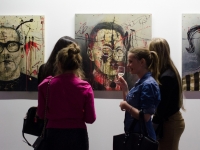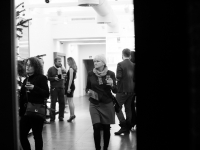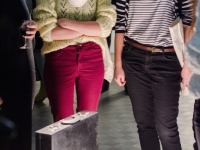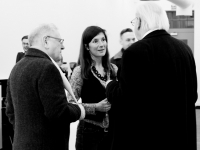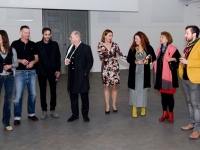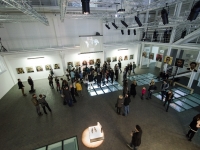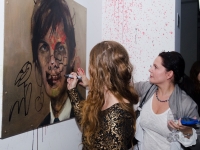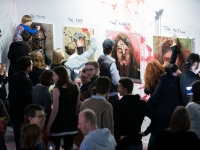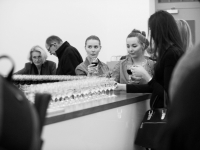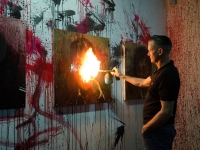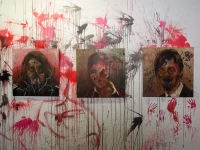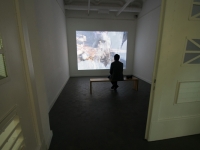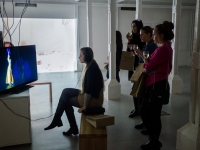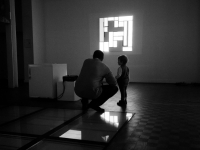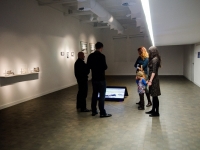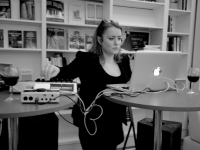THRESHOLDS | TRAFO
15 December 2013 – 26 January 2014
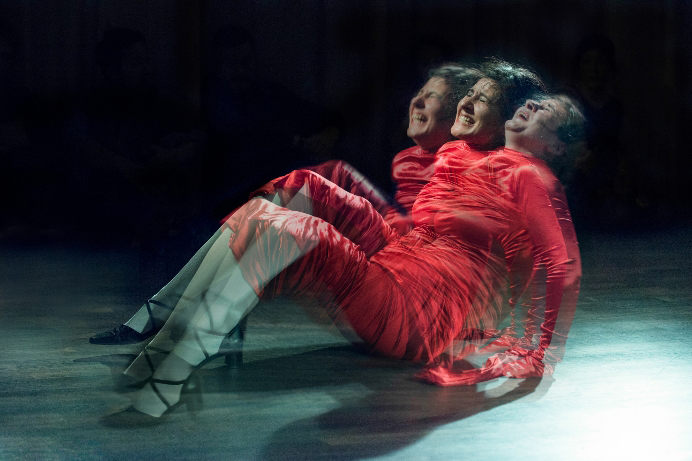
THRESHOLDS travels to
TRAFO Center for Contemporary Art
Trafostacja Sztuki w Szczecinie
4 Świętego Ducha st., 70-205 Szczecin, Poland
In Partnership with the Collegium Hungaricum Berlin and TRAFO Art Foundation
Curated by Vera Baksa-Soos, David Elliott, Constanze Kleiner, Rachel Rits-Volloch, and David Szauder
– Free and open to the public –
THRESHOLDS is a cooperation between MOMENTUM, the Collegium Hungaricum Berlin, and TRAFO Center for Contemporary Art. The first edition of THRESHOLDS was hosted by the.CHB in September 2013, during Berlin Art Week. THRESHOLDS has commissioned two performances and a panel discussion on curating performance art, in addition to exhibiting the MOMENTUM Collection and Performance Archive alongside seminal works of video art from Hungary, and a selection of video art from the 1st Kiev Biennale. The second edition of THRESHOLDS held at TRAFO Center for Contemporary Art in Szczecin expands on this program, including an Artist Residency Exchange between MOMENTUM and TRAFO, and includes additional video works from the MOMENTUM and .CHB programs.
OPENING VIDEO:
 |
FEATURING:
The MOMENTUM Collection
ERIC BRIDGEMAN, OSVALDO BUDET, NEZAKET EKICI, DOUG FISHBONE, JAMES P. GRAHAM, MARIANA HAHN, MARK KARASICK, HANNU KARJALAINEN, JANET LAURENCE, GABRIELE LEIDLOFF, SARAH LÜDEMANN, KATE MCMILLAN, DAVID MEDALLA, TRACEY MOFFATT, MAP OFFICE, KIRSTEN PALZ, FIONA PARDINGTON, MARTIN SEXTON, SUMUGAN SIVANESAN, SHONAH TRESCOTT, TV MOORE, MARIANA VASSILEVA
 |
The MOMENTUM Performance Archive features videos of performances commissioned by or staged at MOMENTUM. Including works by:
JOYCE CLAY, CATHERINE DUQUETTE, NEZAKET EKICI, MARIANA HAHN, EMI HARIYAMA AND MARIANA MOREIRA, KATE HERS, JARIK JONGMAN, SARAH LÜDEMANN AND ADRIAN BRUN, KIRSTEN PALZ, SUMUGAN SIVANESAN, YULIA STARTSEV, TRAVELING SOULS
 |
Collegium Hungaricum Video Program complements MOMENTUM’s international video selection with its own selection of Hungarian video art of the past 10 years. Reflections on personal experiences, gender and social critical aspects play a significant role in the curatorial selection of these works. Including works by:
ERIKA BAGLYAS, MONA BIRKÁS, GÁBOR BÓDY, JÁNOS BORSOS, RÓZA EL-HASSAN, MARCELL ESTERHÁZY, DÁVID GUTEMA, EDINA CECÍLIA HORVÁTH, ISTVÁN ILLÉS, JUDIT KIS, SZABOLCS KISSPÀL, DORA MAURER, MIKLÓS MÉCS, HAJNAL NÉMETH, DAVID SZAUDER, ANNAMÁRIA SZENTPÉTERY
 |
The Best of Times, The Worst of Times Revisted: Selected Video Works from the 1st Kiev Biennale, Curated by David Elliott
JOHN BOCK, LUTZ BECKER, YANG FUDONG, GULSUN KARAMUSTAFA, TRACEY MOFFATT, MAP OFFICE, AND MIAO XIAOCHUN
Sky Screen: Mass and Mess, Curated by David Szauder
BART HESS, ISTVAN HORKAY, GYÖRGY KOVÁSZNAI, ADAM MAGYAR, EVA MAGYAROSI, DAVID MOZNY
TRAFO Artist Residency
ANDREAS BLANK, JARIK JONGMAN
TRAFO Cooperations
CHRISTIAN JANKOWSKI
____________________________
TRAFO Trafostacja Sztuki in Szczecin is the first center for contemporary art in the northwest of Poland. Founded in 2013, and located in a renovated historic power station, TRAFO takes advantage of its geographical potential – the cross-border location within the Baltic Sea region and the immediate vicinity of Berlin, the cultural capital of this part of Europe. It acts as a unique “display window” through which Szczecin confronts its artistic image with the world.
The Collegium Hungaricum, founded in 1924, is a prominent multidisciplinary cultural institution dedicated to the exploration of art, science, technology and lifestyle in Berlin. The mission of the .CHB is to actively stimulate discourse pertaining to current issues, ideas and concepts, in order to further enrich the dialogue surrounding the European cultural experience while simultaneously disseminating Hungarian culture through various events. The Collegium Hungaricum is a part of the Balassi Institute for the promotion of Hungarian culture and also acts as host to the Moholy-Nagy Galerie.
The Foundation For German-Polish Cooperation supports friendly relations between the Poles and the Germans. For the last 20 years, the Foundation for German-Polish Cooperation has co-financed over 10 000 bilateral projects, thereby contributing to the foundations of Polish-German dialogue. The main goal of the Foundation is the support of valuable Polish-German cooperation. The Foundation is supporting the Artist Residency exchange between MOMENTUM Berlin and TRAFO Center for Contemporary Art in Szczecin.
The MOMENTUM Collection was established in 2010 through the generosity of a small group of artists who were involved in MOMENTUM’s inaugural event in Sydney. The donations of their works constituted their investment in MOMENTUM’s then-nascent model as a global and mobile platform for showing time-based art. Three years later, the MOMENTUM Collection has expanded from its original roster of 10 to 25 artists. The Collection represents a cross-section of predominantly digital artworks at the top of the field. It ranges from some of the most established to emerging artists and includes work from Australia, New Zealand, Korea, Hong Kong, the Philippines, Puerto Rico, Finland, the US, the UK, Bulgaria, Turkey, Poland and Germany. The growth of the Collection reflects the growth of MOMENTUM itself. While we develop and nurture our relationships with these artists, we continually endeavor to bring their work to new audiences worldwide. We are honored to present this iteration of the MOMENTUM Collection at TRAFO Center for Contemporary Art in Szczecin. Due to the unique nature of its growth, the Collection especially lends itself to inquiry into time-based art. Like the works that constitute it, the Collection both sets apart time (to be etched onto a hard drive, recorded on film, or projected across a gallery wall) and is constantly changed by the passing of time itself. The MOMENTUM Collection, including Artist Bios and Statements can be seen by following the link to MOMENTUM COLLECTION.
 |
 |
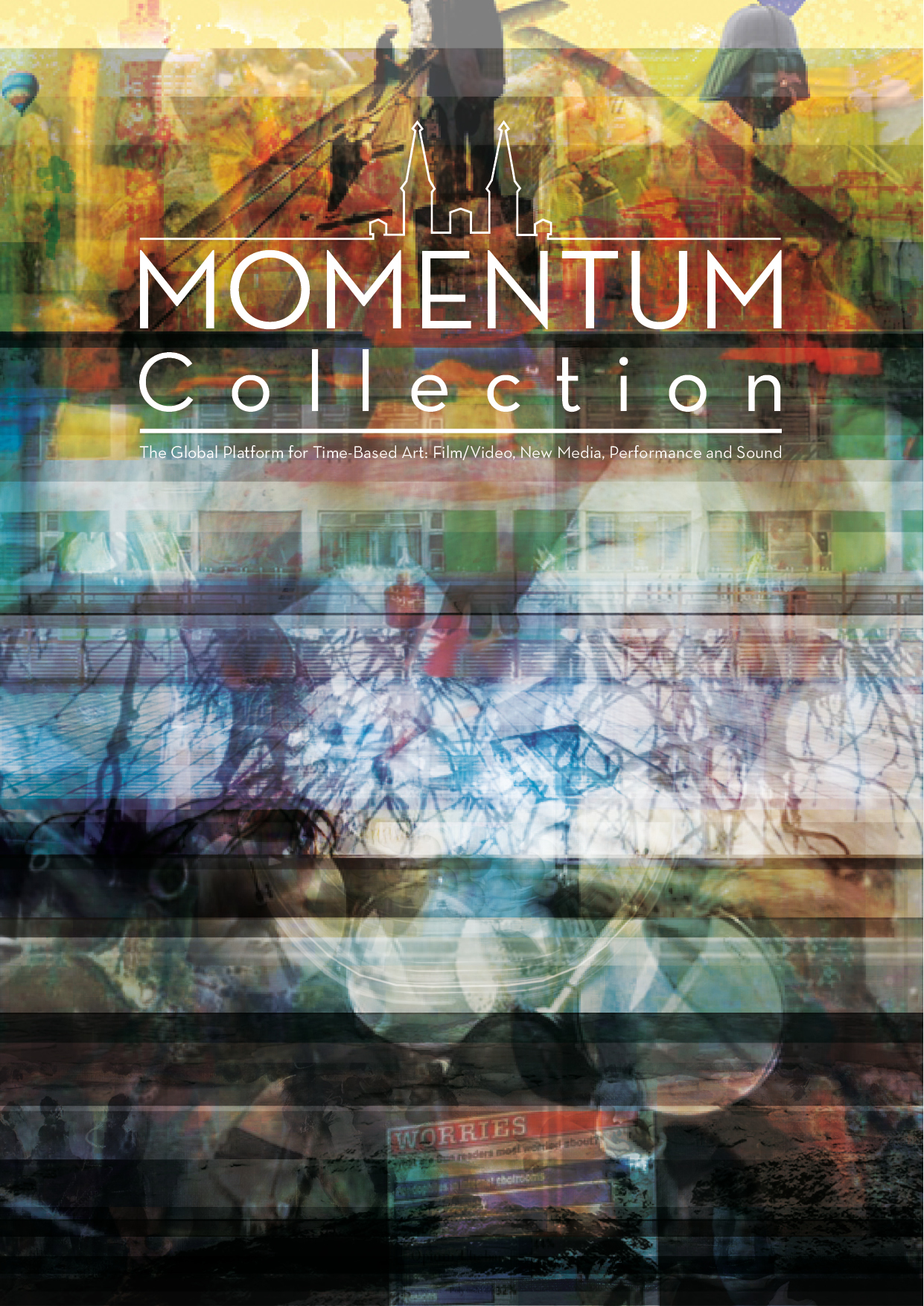
____________________________
Featuring:
Lutz Becker, John Bock, Yang Fudong, Gülsün Karamustafa, Tracey Moffatt, Map Office, and Miao Xiaochun
Curated By David Elliott
This special program of video works was originally screened at the 1st Kiev Biennale in 2012, curated by the Artistic Director of the Biennale, David Elliott. The works were on view at MOMENTUM Berlin and also as part of our SKY SCREEN initiative at SALT Istanbul and on the media facade of the Collegium Hungaricum Berlin.
Echoing the first words of A Tale of Two Cities (1859), Charles Dickens’ famous novel set at the time of the French Revolution, this exhibition jumps forward to the present to consider how contemporary art and aesthetics use the past to express the future. The ideals of Human Rights developed during 18th Century European Enlightenment found their first political expression in the American and French Revolutions. Yet, in spite of fine intentions at the outset, Human Rights have been constricted as each revolution has contained at its core the worst as well as the best of human thought and action. This program reflects on utopian dreams of freedom, equality, and security that are very much at the heart of our lives today, as well as on their opposite: terror, inequity and war. It is the destructive forces of both man and nature that seem to make a more ideal life impossible. Showing simultaneously across three locations in Berlin and Istanbul, revisiting this selection of works is a timely response to the current situation in Turkey, where ideals of democracy and freedom have been brought into renewed focus.
The artist Miao Xiaochun, who is part of this program, is currently representing the People’s Republic of China in the 55th Venice Biennale.
ARTISTS and WORKS:
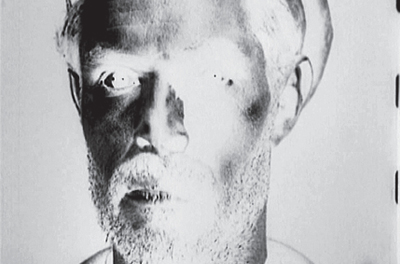
Lutz Becker, THE SCREAM, 2012
Born in 1941 in Berlin, Germany lives and works in London, UK. Lutz Becker is an artist, filmmaker, curator and film-historian. He studied at the Slade School of Fine Art, London, where he graduated under Thorold Dickinson and became a distinguished director of political and art documentaries. A practicing painter, he is also a curator of exhibitions. He collaborated with the Hayward Gallery on The Romantic Spirit in German Art (1994), Art and Power (1995), and Tate Modern on Century City (2001). As of 2003, Becker has been working for the Mexican Picture Partnership ltd.’s reconstruction project of Sergei M. Eisenstein’s film ¡Que viva Mexico! ‒ Da zdravstvuyet Meksika!.
THE SCREAM
‘The video installation The Scream is an homage to the Ukrainian filmmaker and poet Aleksandr Dovzhenko (1894-1956). It is a reflection on Dovzhenko as a poet who told his stories in the form of the classical eclogue, in which pastoral simplicity stands in contrast with modernist self-consciousness. Even in his more overtly political films Dovzhenko’s perspective remained subjective, attached to the old art of story telling, its allegorical elements, symbols and types. The installation, originally presented on three screens, is shown here as a single-channel version especially created for this exhibition. The work is a montage of segments from Dovzhenko’s films, based on dramatic interactions and accidental synchronicities of images and scenes, the play of affinities and contrast, textures, details, and the monumentalisation of the human face’.
 |
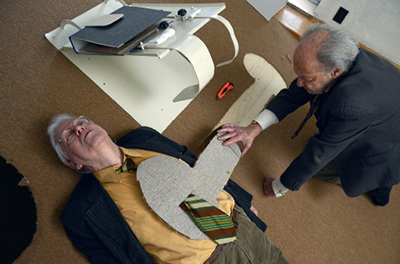
John Bock, MONSIEUR ET MONSIEUR, 2011
Born in 1965 in Gribbohm, Germany lives and works in Berlin, Germany. John Bock makes lectures, films and installations that combine and crosspollinate practices of language, theatre and sculpture in an absurd and complex fashion. He is known for producing surreal, disturbing and sometimes violent universes in which he manipulates fantasmagorical machines constructed out of waste and found objects. Bock actively collapses the borders of performance, video and installation art. Raised in a rural area of Germany (a background that he has drawn upon for his films involving tractors and rabbits), Bock came to prominence in the 6th Berlin Bienniale (1998), the 48th Venice Biennale (1999) and Documenta 11 in Kassel (2002). He was initially known for his unpredictable, sprawling live performances in which he brings together uncanny costumes, jury-rigged sets made from tables, cupboards and simple machinery, and his own wildly discursive lecturing style. Clad in bright and excessive cloth appendages and covered in sickly materials, Bock interacts with handmade assemblages and inanimate objects that reference a range of social, scientific and philosophical structures. Following the less florid practice of Joseph Beuys, the settings and objects remain in the exhibition space as installations in the aftermath of his lectures. Moving from early documentation videos of performances, Bock has recently begun to work on more complex videos and films that play with the structures and genres of cinema. He uses spectacular settings and costumes, rapid-fire editing, and a mix of sound and popular music to stage narratives that reference such broad fields as 1990s Hollywood cliché, 1970s Glam Rock and nineteenthcentury dandyism. He does not appear personally in Monsieur et Monsieur, 2011, the film shown here, but instead plays the role of director of this bizarre, kafkaesque nightmare.
 |
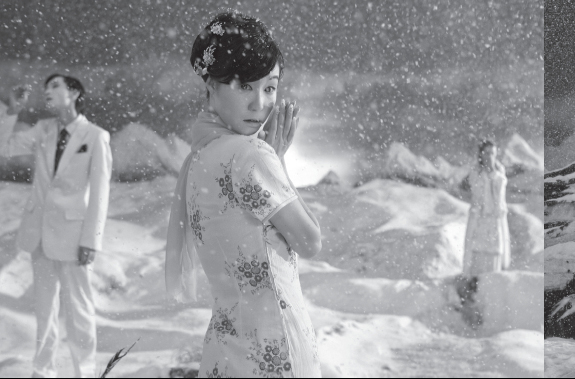
Yang Fudong, YEJIANG / THE NIGHTMAN COMETH, 2011
Born in 1971 in Beijing, China lives and works in Shanghai, China. Yang Fudong’s films, photographs and video installations are born out of an interest in the power of the moving image to explore subjectivity, experience and thought. He draws stylistically on different periods in the history of Chinese cinema to create open ended existential narratives that interweave quotidian ritual with dream and fantasy states. Yang trained as a painter in the China Academy of Fine Arts in Hangzhou. In the 1990s, he started to work in the medium of film and video. He is known for his cinematography and mastery of cinematic style, using 35mm film to produce powerful and poetic works about the human condition with its malaise and fantasies of everyday life. He possesses a sensitivity to the traditions of Chinese art, cinema and the place of the intellectual (the literati). Each of his films is philosophical and open-ended, engaging questions around both history and contemporary life, mostly depicting the lives of young people from his own generation, albeit with historical resonances that sometimes span many centuries. Through vignettes staged with classical precision, yang’s works propose a poetics of place and a critique of time that is determined through the interaction of individuals rather than by political doctrine.
THE NIGHTMAN COMETH / Ye Jiang
The single screen work shown here, unfolds in the realm of historical fantasy. An ancient warrior is seen wounded and forlorn after battle, in conflict about his path in life. Three ghost-like characters appear as emblems of feelings and thoughts that surface and clash within the warrior’s heart and mind as he has to decide whether to disappear or continue fighting. Yang has preferred to describe this film as ‘neo-realistic’ rather than historical or allegorical: Neo-realism” is a history theatre where current and contemporary social conditions come to play. Who exists realistically, the warrior baron in his period costume or the ghost in a modern outfit? When the ancient battlefield scene and other historical events appear and reappear, where do they belong, in the past, the present or the night-falling future?…. There is hope nonetheless. The body is full of desire whereas the soul is more precious. His spirit is what backs him up in life. How should we live our lives now? How do we identify ourselves with neorealistic historical events and continue to search for spiritual meanings? What do we really want?” [DE]
 |
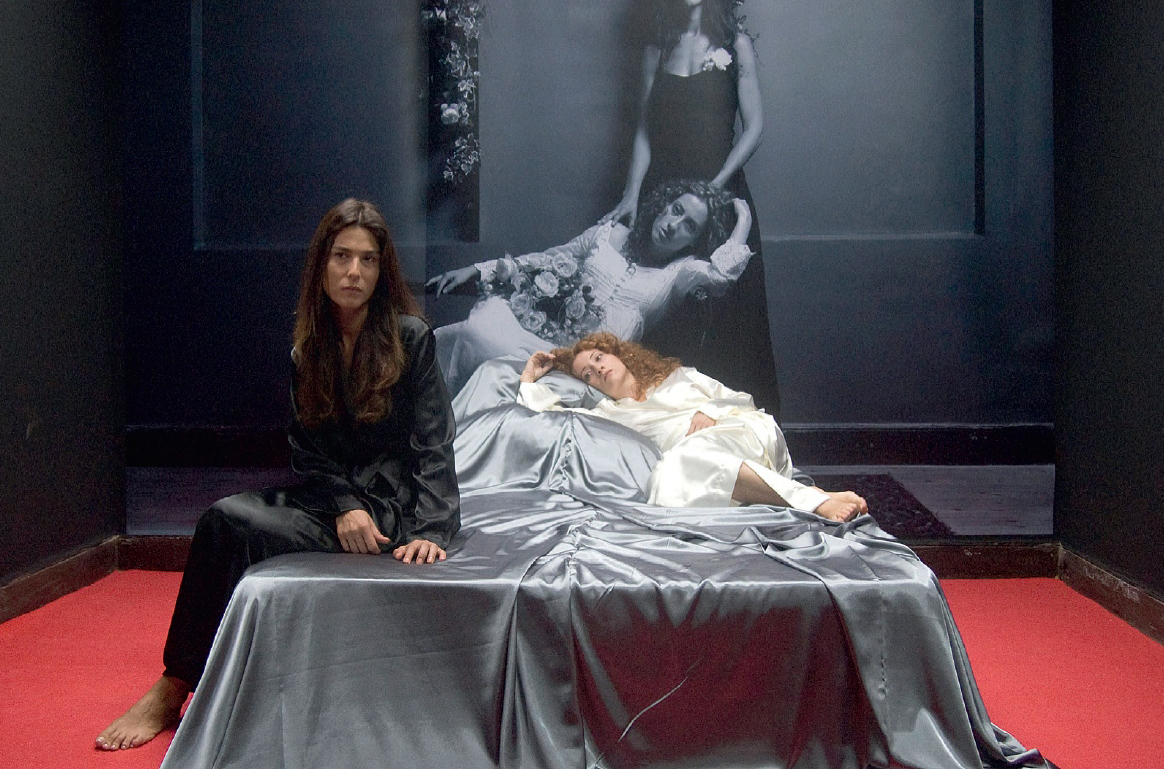
Gülsün Karamustafa, INSOMNIAMBULE, 2011
Born in 1946 in Ankara, Turkey lives and works in Istanbul, Turkey. Working in diverse media throughout her four-decade-long career, Karamustafa has investigated ideas of mobility, including displacement, immigration, expatriation, exile, and relocation.
INSOMNIAMBULE
Insomniambule follows the nightly journeys of two characters, Somnambule and Insomniac. While one gives clues that she is suffering from nightly sleepwalks, the other stands in contrast as a symbol of constant consciousness. Though they seem to depict the heterogeneity of being awake and asleep, at their core, the two states exhibit distinct similarities. Both are fighting against the state of sleep ‒ Insomniac deliberately rejecting sleep and trying to keep consciously awake while Somnambule struggles against deep slumber from within an already induced state of sleep. From either side, both characters must find a way to adapt themselves to normal life. The characters pass through the doors of memory and recollection, subconsciously playing several games that lead them through both personal and social past and present. The two characters, represented by the women who constantly follow one another, accentuate the uncanny sensation and weird relationship of being split into two. Therefore Insomniac and Somnambule can easily join together to form the word Insomniambule, which symbolizes them both. It also creates a platform for understanding the connection between artistic creativity and the twin conditions of insomnia and somnambulance.
Running concurrently with MOMENTUM’s video program, Gülsün Karamustafa has a major retrospective of her work at SALT, our partner for SKY SCREEN in Istanbul. The solo show, A PROMISED EXHIBITION, runs from 10 September 2013 – 5 January 2014. For more information, please click here: SALT.
 |
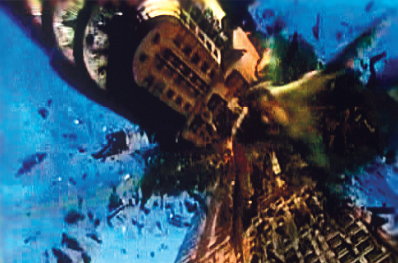
Tracey Moffatt, DOOMED, 2007
Born in 1960 in Brisbane, Australia, lives and works in Australia and USA. Tracey Moffatt is one of Australia’s leading contemporary artists as well as being an artist of international significance. She has had numerous solo exhibitions in major museums around the world. Working in photography, film and video, Moffatt first gained significant critical acclaim when her short film Night Cries was selected for official competition at the 1990 Cannes Film Festival.
DOOMED
Tracey Moffatt’s video collage, Doomed, features depictions of doom and destruction ‒ war, violence and terror ‒ as they appear in popular cinema. In collaboration with Gary Hillberg, with whom she made Other (2009), Love (2003), Artist (2000) and Lip (1999), Doomed uses cut-and paste editing techniques in a highly entertaining and black-humorous take on the bleak side of our current psychological landscape. Moffatt’s film looks at both entirely fictional and reconstructed disastrous events. Each scene carries a particular cargo of references. They occupy their own unique symbolism and filmic territory ‒ the poignant, sublime and epic, the tragic, the B-grade and downright trashy. The accumulation of scenes, however, within Moffatt’s own essaying, creates a narrative whole comprised of parts. Not only does Moffatt play within the ‘disaster’ genre, re-presenting representations, she revels in it. Moffatt points at how the viewer is involved in filmic narratives through an emotional hook, by the promise of imminent disaster, an important narrative device. Moffatt’s film itself is crafted with an introduction, body and finale ‒ in a presentation of the form of filmic entertainment, as well as of ‘art as entertainment’.
 |
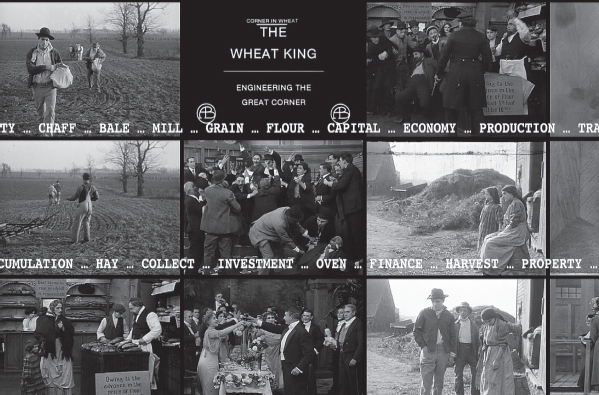
Map Office, OVEN OF STRAW, 2012
MAP OFFICE is a multidisciplinary platform devised by Laurent Gutierrez (b. 1966, Casablanca, Morocco) and Valérie Portefaix (b. 1969, Saint-Étienne, France). This duo of artists/architects has been based in Hong Kong since 1996, working on physical and imaginary territories using varied means of expression including drawing, photography, video, installations, performance, and literary and theoretical texts. Both are teaching at the School of Design, The Hong Kong Polytechnic University.
THE OVEN OF STRAW
Ukraine is traditionally the barn of Europe and one of its most important agricultural producers. Against a background of food crisis and financial speculation on agriculture, we would like to use wheat as a point of entry for thinking about the impact of speculation on the land. The Oven of Straw was originally a video installation, and is shown here as a film weaving together narrative fragments linked by their relation to wheat. The installation was a small construction inviting the visitors to enter a confined space in the shape of an oven made of straw. The structure of the oven echoes the structure of a bank with its thick wall and small entrance suggesting the opposite effects of potential danger and safety. The interior is designed like a small cinema, where visitors are presented a short film. Mixing archival material from various films, Oven of Straw explores the role of wheat as a valued system of exchange.
 |
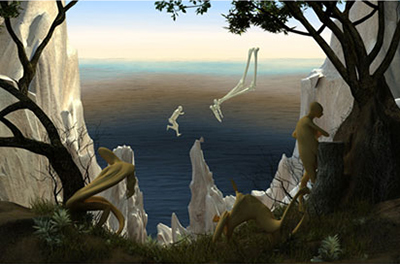
Miao Xiaochun, RESTART, 2008-2010
Born in 1964 in Wuxi, Jiangsu, China lives and works in Beijing, China. Miao Xiaochun graduated from the Central Academy of Fine Arts (CAFA), Beijing, China and the Kunsthochschule Kassel, Germany. He is presently a professor at CAFA and one of the leading digital artists in China. While studying in Europe he familiarised himself with western art history and motifs from famous classic paintings are often animated in his videos. Miao Xiaochun is considered one of the most representative and influential artists In the domain of China’s new media art. He started in 90s his creative explorations on the interface between the real and the virtual. His extensive body of work includes photography, painting and 3D computer animation which are parallel to each other. He works in contemporary photography based on the “multiple view point” perspective to pioneer connections between history and the modern world. Miao Xiaochun successfully uses 3D technology to create upon a 2D image a virtual 3D scene, to transform a still canvas into moving images, concurrently changing the traditional way of viewing paintings and giving a completely new interpretation and significance to a masterpiece of art, especially with the striking use of his idiosyncratic imagination about history and the future. His works add an important example to contemporary negotiations with art history, and open up new potential for art as he experiments with new possibilities, taking a step forward into new potential spheres.
RESTART
The apocalyptic 3D video Restart begins with an animation of Pieter Breughel’s The Triumph of Death (c. 1562). Here one famous Western masterpiece morphs into another and classical civilisation crumbles into modern chaos. As the video continues, images of the present begin to take hold, some reflecting China’s recent economic growth and technological prowess. yet no triumphalism is intended in what after all is a continuing cycle. In Xiaochun’s works the naked homogeneity of seemingly oriental CG figures based on the artist’s body, dead or alive, represent everyman ‒ his joys and horrors as well as the endless struggles between life, love and death.
 |
 |
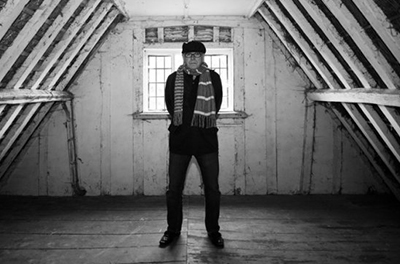
David Elliott
Davıd Elliott is an English born curator and writer. From 1976 to 1996 he was Director of the Museum of Modern Art in Oxford, England, Director of Moderna Museet [The National Museum of Modern and Contemporary Art] in Stockholm, Sweden (1996-2001), founding Director of the Mori Art Museum in Tokyo (2001-2006), the first Director of the Istanbul Museum of Modern Art [Istanbul Modern] (2007), Artistic Director of the 17th Biennale of Sydney (2008 – 2010) and Artistic Director of the 1st Kiev International Biennale of Contemporary Art (2011-12), Rudolf Arnheim Guest Professor in Art History at the Humboldt University, Berlin (2008) and Visiting Professor in Museum Studies at the Chinese University in Hong Kong (2008/11/13). From 1998 until 2004 he was President of CIMAM (the International Committee of ICOM for Museums of Modern Art). He is Hon President of the Board of Triangle Art Network/Gasworks in London and on the Asia Advisory Board of the Guggenheim Museum in New York.
THE BEST OF TIMES, THE WORST OF TIMES REBIRTH AND APOCALYPSE IN CONTEMPORARY ART
The Best of Times, The Worst of Times reflects on seemingly utopian dreams of freedom, equality, and security, as well as on their opposites: terror, inequity, poverty and war, that are very much at the heart of our lives today. It is this destructive impulse – some may say necessity – within both man and nature that seems to make a more ideal or stable life impossible. Yet the Kantian idea of artistic autonomy is one of the significant survivors of this age of revolutions. Without it art would always be the servant of some greater power and contemporary criticism would end up as little more than a small, rudderless, leaky boat at the mercy of a boundless, all-consuming tide.
____________________________
IN-PROCESS: THE MOMENTUM – TRAFO ARTIST RESIDENCY EXCHANGE
Featuring:
Andreas Blank and Jarik Jongman
Curated By Constanze Kleiner and Rachel Rits-Volloch
TRAFO Trafostacja Sztuki in Szczecin inaugurates its process-based residency program, in collaboration with MOMENTUM Berlin, supported by the Foundation For German-Polish Cooperation. Through the Residency Exchange, TRAFO hosts the German sculptor Andreas Blank, and the Dutch painter, Jarik Jongman.
A former assistant of Anselm Kiefer, Jarik Jongman uses both his own photographs and anonymous pictures found in flea markets, books, magazines and the internet as a starting point for his work, which often deals with archetypical imagery. Dutch born, he studied in Arnhem and has had numerous exhibitions in London, Berlin, Switzerland, Amsterdam and at the 53rd (2009) and 54th Venice Biennale in collateral events. He lives and works in Amsterdam. Jongman will expand his series of painted portraits of icons of the contemporary art world. Originally developed for the ABOUT FACE exhibition at MOMENTUM in 2012, Jongman has applied traditional oil painting to an interactive performative practice. Painting some of the richest and most influential art-world players of our time, he subsequently invokes the audience to break all the taboos of the relationship between audience and artwork. Giving the audience the tools to leave their mark on the paintings, Jongman encourages the purest form of iconoclasm in the context of the sacred space of the museum. The result is a series of mutilated images, reminiscent of the damaged murals and toppled statues of ousted dictators across the world. This series of work has so far been enacted in Berlin, Jerusalem, and London, with portraits of icons of the art world site specific to each location. For his Artist Residency at TRAFO, Jongman will show the results of the previous performances, in addition to creating five new portraits of icons of the Polish art scene. The subjects of these portraits will be selected through an open call, involving the audiences of Szczecin in the process of art production; in the very first stages of choosing a subject, and in the last step in putting their own signatures on the finished work.
 |
Andreas Blank was born in Ansbach in 1976. He attended the Karlsruhe State Academy of Art (Staatliche Akademie der Bildenden Künste) and was Meisterschüler under Prof. Klingelhöller. He held a scholarship with the German National Academic Foundation and received his MFA from the Royal College of Art in London. In 2009 he was a finalist for the New Sensations Award by Channel 4 and the Saatchi Gallery. Blank lives and works in Berlin. Andreas Blank‘s stone encarved trompe l’oeils seem casual at first sight. However, his arrangements are precisely staged and after closer inspection, one discovers that light bulbs, transport boxes and plastic bags are made of marble, alabaster or sand stone. In his sculptural practice, Andreas Blank combines the abstract and the realistic, the conceptual as well as the technical. He sources stones from quarries from all over the world, carves them with elaborate deliberation and assembles them in sometimes consciously stylized, and other times deceptively realistic objects of the everyday. In his precise installations, the apparently ephemeral objects achieve monumental permanence. Whether marble, alabaster, or porphyry, material historically used to serve religious or political functions, has in Blank’s hands acquired a seemingly casual and fragmentary character. The geographical and cultural identity of the stone and the memorial function of stone-sculpture in general refer to the value of each object. Blank questions the obvious and transforms traditional ideals and values on the ordinary and present. As Artist-In-Residence at TRAFO, Blank will show a selection of his previous work, and will make a new sculpture in dialogue with these previous works.
 |
____________________________
THRESHOLDS COMMISSIONED PERFORMANCES
Featuring:
THE TUBE by Nezaket Ekici, and THRESHOLDS by Marcus Doering, Emi Hariyama, Peter Kirn, and Szilvia Lednitzky
Comissioned and Co-Produced by MOMENTUM and Collegium Hungaricum Berlin
Including documentation of the live performance on the occasion of the opening of the exhibition at Collegium Hungaricum in September, by Nezaket Ekici. This performance, re-enacting her 2008 work, TUBE (duration 30 minutes), is based on the 1925 Otto Dix painting Anita Berber. Dix’s painting of Berber, a dancer and actress who was considered the embodiment of the 1920′s femme fatale, depicts her in a tight, red dress. Ekici, in turn, squirms and dances her way into a five meter long, red cloth tube with overly long arms. Behind Ekici, a projection depicts the artist in a snow-covered Canadian landscape, wearing the same red dress. The audience is thus confronted with two different yet corresponding worlds on the threshold of two mediums: the live performance, its projected mirror, and everything that happens in the space in between. Ekici is a Turkish-born, Berlin-based performance artist who trained with Marina Abramovich. Following in her tradition of extreme durational statements, Ekici’s work is focused on her body and the gaze of the spectator which sustains the performance.
Also including documentation of the interdisciplinary performance, THRESHOLDS, on the occasion of the opening of the exhibition at Collegium Hungaricum in September.
THRESHOLDS Performance was Created, Choreographed, and Directed byEmi Hariyama (Staatsballet Berlin) Dr. Marcus Doering, Interactive Light Design Specialist
Music composed by Bela Bartok, György Ligeti, Peter Kirn, and Szilvia Lednitzky
What happens when a ballerina meets Germany’s most innovative light design specialist in an responsive, interactive performance? The live score, performed by contemporary electronic producers Peter Kirn and Lower Order Ethics (Szilvia Lednitzky), will combine and improvise on self-collected samples. In asking these artists to work together, we have given them free reign to develop their own expressions towards this location and their own answers to the question MOMENTUM continuously poses: What is time-based art? Transgressing disciplinary boundaries and drawing together their creative synergies, these performers embody MOMENTUM’S mission to enable great art to happen across cultural and institutional borders.
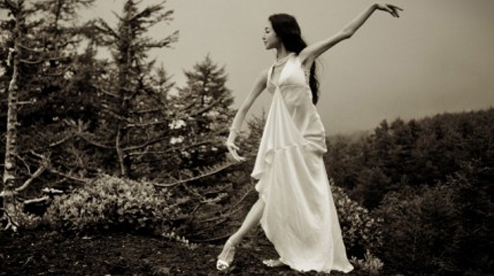
Emi Hariyama is a ballerina born in Osaka, Japan. She graduated from Bolshoi Ballet School in Moscow in 1996. She joined the Moscow Ballet Theater and the Aalto Ballet Theater in Essen, Germany in 1997. She has won numerous international competitions, including the Special Prize at Moscow International Ballet Competition, a bronze medal at the New York International Ballet Competition, and a silver medal at the International Ballet Competition in Paris (no gold was awarded). Since 2004, Emi Hariyama has been a member of ”Staats Oper Unter den Linden” and ”Deutsche Oper Berlin” under the direction of the maestro Vladimir Malakhov.
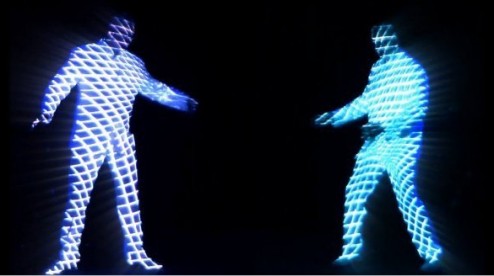
Dr. Marcus Doering holds a PhD in Physics and has made a name for himself with pmd-art for innovative light design. Together with André Bernhardt and the designers of büro+staubach, he realizes interactive worlds of experience. The three-dimensional illuminations and real-time projections on actors and objects that are moving through space correspond exactly to their contours, calculated by a specially developed 3D computer model. In Berlin, Marcus participated with interactive LED zones during the “Festival of Lights“ 2011 and the “Magical Mystery Show“ at the Wintergarten Variété.
Peter Kirn is an audiovisual artist, journalist, and technologist. Classically trained in composition and piano, he now focuses on live electronic performance. He is the founder of CDM, a widely-read daily site that explores creative technology, and has contributed to Macworld, Popular Science, De:Bug, Keyboard, and others. He teaches and develops open creative tools, including co-creating the open source MeeBlip synthesizer. Born in Kentucky, he is now based in Berlin. He is a PhD Candidate in Music Composition at The City University of New York Graduate Center.
Szilvia Lednitzky (Lower Order Ethics), born in Budapest, is known in the electronic music scene for her tense and masterful transmissions on the edge of welcome sonic paranoia. Flirting with borderline gothic and harsh industrial, her sonic world pries open the doors of noise’s secret chambers, conjuring up smoky, hypnotic images of endless nights spent in daze. Lower Order Ethics is currently undertaking DJ-shows at selected cultural events around Europe, researching Hungarian and Middle-Eastern ethnomusicology at the same time.


 Back to Homepage
Back to Homepage